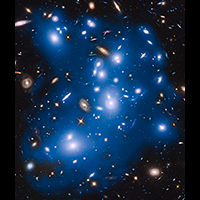Hubble Sees 'Ghost Light' From Dead Galaxies
2014-10-30 
By observing the light from the orphaned stars, Hubble astronomers have assembled forensic evidence that suggests as many as six galaxies were torn to pieces inside the cluster over a stretch of 6 billion years. Computer modeling of the gravitational dynamics among galaxies in a cluster suggest that galaxies as big as our Milky Way are the likely candidates as the source of the stars. The doomed galaxies would have been pulled apart like taffy if they plunged through the center of the galaxy cluster where gravitational tidal forces are strongest. Astronomers have long hypothesized that the light from scattered stars should be detectable after such galaxies are disassembled. However, the predicted "intracluster" glow of stars is very faint and was therefore a challenge to identify.
For a little more insight into the project see this:
http://hubblesite.org/newscenter/archive/releases/2014/43/full/

 Search
Search

